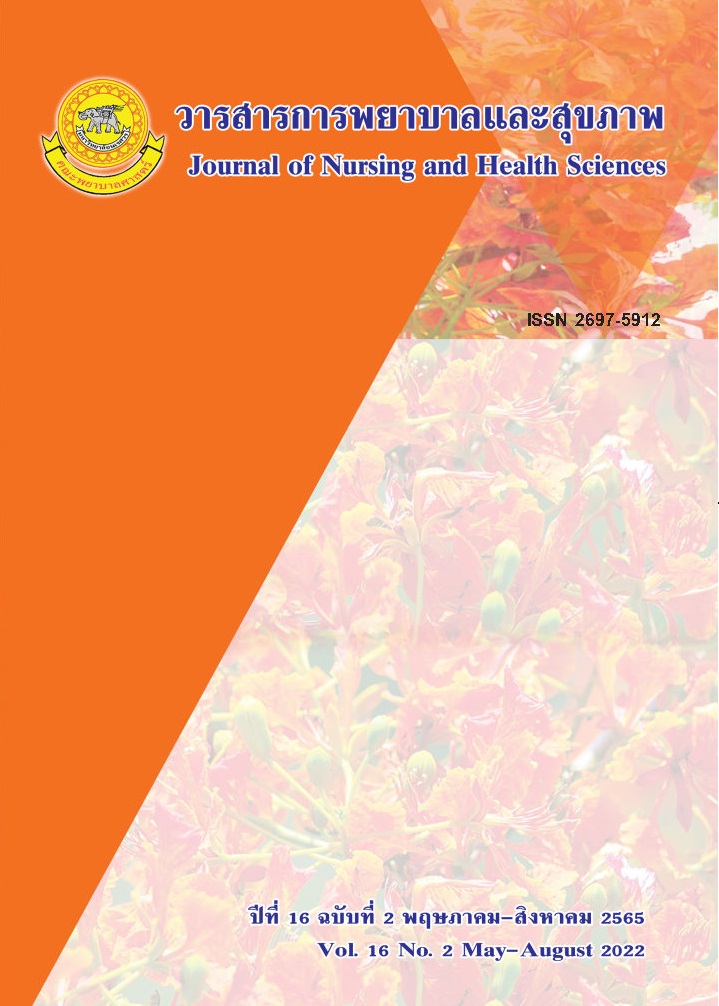Antibacterial Activity of Mandelic Acid Against Klebsiellae Pneumonia
Main Article Content
Abstract
Mandelic acid was a synthetic substance or naturally extracted substance for the purpose of antibacterial
treatment of skin infectionscaused by Staphylococcusaureus with minimum inhibition concentration of
2.50 mg/ml. There had been no reports about antibacterial activity of mandelic acid against Klebsiella pnemoniae.
This study investigated the antibacterial activity of mandelic acid against Klebsiella pnemoniae ATCC BAA-
1705 by disk diffusion method and broth macrodilution method for minimum inhibition concentration and
minimum bactericidal concentration according to Clinical and Laboratory Standards Institute. The results
showed that the diameter of inhibition zone of mandelic acid at 0, 0.0152, 0.0304, 0.0608 and 0.0912
mg/ml presented 6.00 ± 0.00 mm by disk diffusion methodwith interpretation of no antibacterial inhibition.
Minimum inhibition concentration and minimum bactericidal concentrationof mandelic acid displayed
2.50 mg/ml and 2.50 mg/ml by broth macrodilution method, respectively. In conclusion, there was no
antibacterial activity of mandelic acid against K. pneumoniae by disk diffusion methodbut there was
antibacterial activity of mandelic acid against K. pneumoniae by broth macrodilution method. Hence,
this preliminary data had been useful to studythe antibacterial activity of mandelic acid against
K. pneumoniaisolated from clinical specimens of patients with skin infections in the future.
Article Details

This work is licensed under a Creative Commons Attribution-NonCommercial-NoDerivatives 4.0 International License.
References
Ahmed, M. I. (2012). Prevalence of nosocomial wound
infection among postoperativepatients and
antibiotics patterns at Teaching Hospital in Sudan.
North American Journal of Medical Sciences,
(1), 29-34.
Broberg, C. A., Palacios, M., & Miller, V. L. (2013).
Whole-genome draft sequences of three
multidrug-resistant Klebsiella pneumoniae strains
available from the American Type Culture
Collection. Genome Announcement, 1(3), e003
-13.
Clinical and Laboratory Standards Institute. (2009).
Methods for dilution antimicrobial susceptibility
for bacteria that growth aerobically (8th ed.).
Approved standard M7-A8. Wayne, PA, USA:
Clinical and Laboratory Standards Institute.
Clinical and Laboratory Standards Institute. (2009).
Performance standards for antimicrobial disk
susceptibility tests (10th ed.). Approved standard
M2-A10. Wayne, PA, USA: Clinical and Laboratory
Standards Institute.
Clinical and Laboratory Standards Institute. (2010).
Performance standards for antimicrobial
susceptibility testing. Nine-teenth informational
supplement. M100-S20. Wayne, PA, USA:
Clinical and Laboratory Standards Institute.
Enrico, G., Lucia, F., & Roberto, P. (2019). Dermabrasion
with non-ablative electrosurgery and peeling
with mandelic acid and lactoferrin in the
treatment of perioral wrinkles. Dermatology
Research,1(1), 1-5.
Findlay, J., Hamouda,A., Dancer, S.J., & Amyes,
S. G. B. (2012). Rapid acquisition of decreased
carbapenem susceptibility in a strain of Klebsiella
pneumoniae arising during meropenem therapy.
Clinical Microbiology and Infection, 18(2), 140-146.
Foerster, S., Unemo, M., Hathaway, L. J., Low, N., &
Althaus, C. L. (2016). Time-kill curve analysis
and pharmacodynamic modelling for in vitro
evaluation of antimicrobials against Neisseria
gonorrhoeae. BMC Microbiology, 16(1), 1-11.
Hussain, S., Rahim, J., & Farooqui, M. (2012). Studies of
binary complexes of metal ions with mandelicacid
by potentiometry.Chemistry Journal, 2(6), 206-209.
Jeon, J. M., Lee, H. I., Kim, S. G., Han, S. H., & So, J. S.
(2010). Differential inactivation of food poisoning
bacteria and Lactobacillus sp. by mandelic acid.
Food Science and Biotechnology, 19(3), 583-587.
Kamienny, F. M., Barr, M., , & Nagwekart, J. B. (1969).
Mutual inhibitory effect of (-)-mandelic acid and
certain sulfonamides on the kinetics of their urinary
excretion in humans. Journal of Pharmaceutical
Sciences, 58(11), 1318-1324.
Kaye, K. S., Petty, L. A., Shorr, A. F., & Zilberberg,
M. D. (2019). Current epidemiology, etiology,
and burden of acute skin infections in the United
States. Clinical Infectious Diseases,68, S193-199.
Mitrea, L., & Vodnar, D. C. (2019). Klebsiella
pneumonia-a useful pathogenic strain for
biotechnological purposes: Diols biosynthesis
under controlled and uncontrolled pH levels.
Pathogens,8(4), 293.
Motamedifar, M., Bazargani, A., Namazi, M. R, &
Sarai, H. S. E. (2014). Antimicrobial activity
of mandelic acid against methicillin-resistant
Staphylococcus aureus: a novel finding with
important practical implications. World Applied
Sciences Journal, 31(5), 925-929.
Nassif, X. Fournier, J. M., Arondel, J., & Sansonetti, P. J.
(1989). Mucoid phenotype of Klebsiellapneumoniae
is a plasmid-encoded virulence factor. Infection
and Immunity, 57(2), 546-552.
Patel, J. B., Tenover, F. C., Turnidge, J. D., & Jorgensen,
J. H. (2011). Susceptibility test methods: Dilution
and disk diffusion methods. In J. Versalovic,
(Ed.), Manual of clinical microbiology (10th ed.)
(pp.1122-1143). Washington, D.C., USA: ASM
Press.
Patil, S. B., Paramne, A., & Harsh, S. (2016). Antibiotic
susceptibility of woundisolates in plastic surgery
patients at a tertiary care centre. Indian Journal
of Plastic Surgery, 49(2), 198-205.
Stan, C. D., Stefanache, A., Tataringa, G., Dragan,
M., &Tuchilus, C. G. (2015). Microbiological
evaluation and preservative efficiency of new
mandelicacid derivatives in ointments. Farmacia,
(4), 577-580.
Taylor, M. B. (1999). Summary of mandelic acid for
the improvement of skin condition. COSMETIC
DERMATOLOGY -CEDAR KNOLLS-, 12(6),
-30.
Tsuji, A. (2002). Transporter-mediated drug interactions.
Drug Metabolism and Pharmacokinetics, 17(4),
-274.


